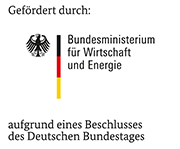18267 N

| Period: | 01.07.2014 - 31.12.2016 |
|---|---|
| Partner: | University Paderborn |
| Funder: | AiF |
| Project Manager: | Dr. Adrian Anthes |
| Research Group: | Corrosion |
Introduction
Magnesium is the 8th most abundant element on
the earth at around 1.94 %. It has a high strength‐to‐weight
ratio and a density which is only 2/3 that of aluminium. Therefore, as the
lightest metallic construction materials, magnesium alloys are often being used in automotive, aerospace and electronic industries.
Unfortunately, most magnesium alloys are not corrosion resistant, so their
application is limited to mild service environments. For a higher durability of
Mg alloys there is a demand for sophisticated coatings with improved corrosion
performance and self‐healing ability. Standard anticorrosion coatings
work with the damage prevention principle,
whereby the metal is only passively protected against corrosion. The next
generation of coatings work with the damage management principle, in this way the coating can react actively on an external trigger
(e.g. pH-value) and release an inhibitor to inhibit further corrosion of the
metal.
Project goals
In the context of this project, an innovative surface technology for corrosion protection of Mg-Alloys should be developed, which generates protective oxide layers with self-healing properties by ultrasound and features cost efficiency and environmental compatibility.
In the course of the IGF-project 358 ZN the encapsulation of an inhibitor into mesoporous SiO2-particles and their electrophoretic embedding in an anodization layer on AZ31 was rudimentarily successful. Within the scope of the given project a further development of the nanotechnological process and a transfer of the integration into ultrasound generated oxide layers should be achieved. For the ultrasound application the optimal parameters (frequency, power) are to be investigated. The nanofiber reinforced layers should be fundamentally and also application-oriented characterized and evaluated relative to their anticorrosive effect and adhesion properties.
Results
The substrate (magnesium wrought alloy AZ31) was pretreated before the coating was applied. The metal surface was ground, degreased, pickled and subsequently activated to get a defined surface for the following coating process.
For the ultrasound-driven growth of a smart oxide layer an aqueous Ce(NO3)3 solution was used, because cerium is well-known as a corrosion inhibitor for magnesium. By introducing ultrasound in an aqueous solution H2O2 is formed in situ, which causes the precipitation of mixed Mg/Ce-oxides on the surface of the substrate. Furthermore, Halloysite nanotubes were added to the aqueous solution to prevent micro crack formation in the artificially produced oxide layer. Through introduction of Halloysite in the ultrasound-driven grown mixed oxide layer it is possible to prepare a homogenous crack-reduced coating, which protects the metal against corrosion. The oxide layer has a cellular morphology and a thickness of ~ 1 µm. This is important because thicker or more solid oxide layers tend to develop cracks which results in poor corrosion protection.
back

Das IGF-Vorhaben Nr. 18267 N der Forschungsvereinigung DECHEMA e.V., Theodor-Heuss-Allee 25, 60486 Frankfurt am Main wurde über die AiF im Rahmen des Programms zur Förderung der industriellen Gemeinschaftsforschung (IGF) vom Bundesministerium für Wirtschaft und Energie aufgrund eines Beschlusses des Deutschen Bundestages gefördert.
Dr. Adrian Anthes
Tel.: 069 / 75 64-279
E-Mail: anthes
A. Anthes, O. Harper, W. FürbethJahrbuch Oberflächentechnik. Bd.72, Leuze, Saulgau/Württ. (2016) 60-69